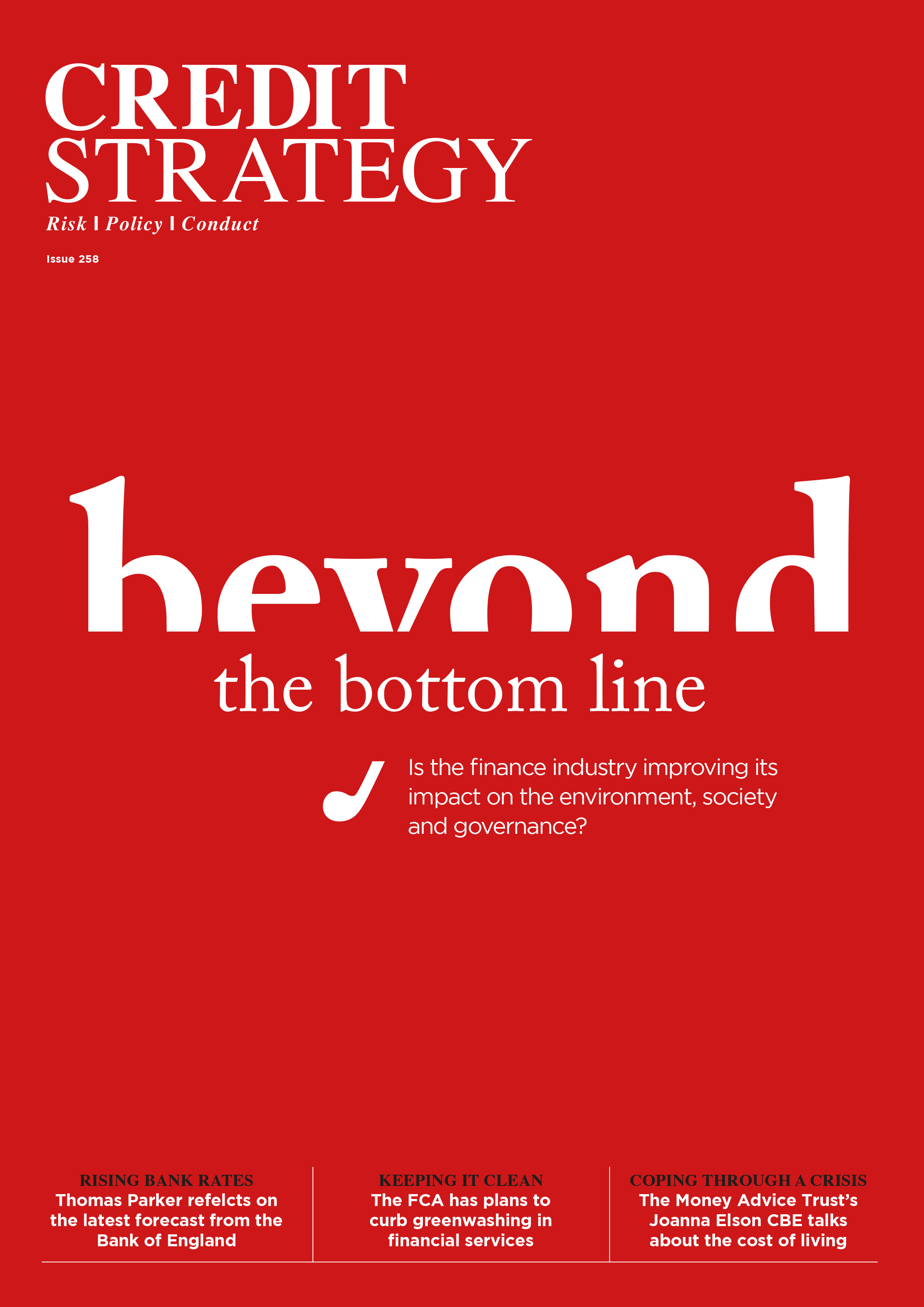Dear visitor,
You're reading 1 of your 3 free news articles this quarter
Register with us for free to get unlimited news, dedicated newsletters, and access to 5 exclusive Premium articles designed to help you stay in the know.
Join the UK's leading credit and lending community in less than 60 seconds.
AI in Lending: Disruption, Ethics and the Future
In an interview with Credit Strategy, director of product at Lenvi, Sam Goodacre shares his perspectives on how AI has disrupted the lending industry in recent years, the potential benefits and risks it presents, including emerging best practices for responsible and transparent AI adoption.
As our relationship with Artificial intelligence (AI) evolves, it presents both exciting opportunities and complex challenges for the lending landscape. While lenders begin to leverage AI’s capabilities for tasks like credit decisioning, fraud detection, and portfolio monitoring, they also grapple with critical ethical considerations and changing regulatory frameworks.
At the precipice of significant AI-driven shifts in the industry, Goodacre offers valuable insights into what’s coming next and the areas that have the potential to drive real, tangible positive change for both lenders and borrowers alike.
How has AI changed credit decisioning in recent years? What are some potential benefits or challenges?
Talking about AI in this context, we need to consider whether we mean AI, generative AI, or machine learning, because there are different applications of those different technologies in different parts of the credit decisioning. The use of some early stages of AI, and some applications of machine learning provide an opportunity for significant change in credit decisioning. I think the major benefits are still on the cusp of taking effect.
Potential benefits for lenders include increased approval rates, increased revenue, reduction in credit loss rates, and increased efficiency through automation. For borrowers, benefits include potentially opening up access to credit for those with thin credit files by utilising alternative data sources enabled by AI and machine learning. It allows for a more holistic, personalised view of the borrower to provide more tailored loan pricing and terms.
Challenges include the need for large datasets to train AI models, the potential for algorithmic bias if the training data has inherent biases, and the need for explainable outcomes to meet regulatory expectations around transparency.
AI provides the opportunity for huge efficiencies but also removes that human touch, which I think is very important within lending. There needs to be some element of human interaction in there to make sure the decision is the right decision.
How can AI be used for fraud detection in lending?
AI provides advanced capabilities like pattern analysis, trend verification, advanced data analytics, real-time monitoring, increased accuracy, and predictive analytics. Traditional rules-based fraud detection systems are limited to identifing known patterns. Generative AI can learn and detect new, emerging fraud patterns autonomously, then flag them for review by human experts.
What about using AI for portfolio monitoring?
AI and machine learning can more accurately predict borrowers’ propensity to default by analysing large datasets in ways humans cannot. This allows lenders to efficiently monitor ongoing creditworthiness and affordability as required.
It wasn’t too long ago that people would have been doing that sort of analysis against a spreadsheet of data. That obviously has flaws, and just can’t react as quickly as we would want. AI also enables more personalised customer experiences, like providing customised repricing offers to low-risk borrowers based on their full profile and behaviour.
You mentioned the ethical consideration of potential biases. Can you expand on that?
In terms of open banking, people are consenting to their financial transactions and financial history being shared with the lender through an open banking connection. But are people really aware they are consenting to an artificial intelligence algorithm making some decisions on their behalf?
There are valid concerns that if the training data for AI models reflects human biases, algorithmic decisions could amplify those biases and lead to unfair outcomes for certain groups like minorities. The FCA’s view on it, which I share, is that it has the real potential to make the situation worse for certain groups of consumers. We need to be careful to ensure unbiased decision making with the use of AI and that we’re doing so in a way that isn’t actually causing consumer harm.
What are the regulatory and compliance challenges around using AI in lending?
The key challenge is how regulators can keep pace with the rapid technological changes brought by AI. The UK government has principles-based AI regulation that existing regulators like the FCA will need to apply on top of their existing frameworks.
Applying blanket AI governance while allowing the technology to evolve at its own pace will be an ongoing discussion to prevent causing consumer harm. Lenders will need to proactively ensure they adopt AI responsibly within regulatory expectations.
What are the best examples of AI that have disrupted the lending industry? Anything that was surprising or stood out?
I found this one quite difficult to answer. A lot of the applications of AI currently are very behind the scenes. For example, using AI and machine learning in credit decision making is not something you can really see or get excited about on the surface.
I’ve seen some good use cases of combining the capabilities of AI with rich data sources like open banking data and traditional credit bureau information to provide predictive behavioural insights for consumers. We’ve explored different use cases ourselves at Lenvi, for example using AI capabilities for document classification, ID verification, and email processing automation.
I don’t feel like I’ve seen something yet that I would say is really disrupting the industry in a big way. We are at the point of a significant shift brought about by AI’s capabilities, but the truly disruptive and mainstream uses are still to come in the next 6-18 months. It’s an exciting time in lending and fintech with companies investing heavily in AI research and development.
Were there any AI technologies that underperformed compared to expectations?
Until last year when ChatGPT 3.5 was released, everything in AI was fairly underwhelming up to that point. Voice activated AI like Alexa had some novelty at first but no real practical applications in lending. The chatbots and self-service capabilities that financial institutions have currently are also significantly underwhelming.
But I think that will change as the technology improves. The difference in capabilities between ChatGPT 4 and Chat GPT 3.5 was significant, and again between ChatGPT 4o and Chat GPT 4. We’ll start to see lenders provide valuable self-service capabilities via AI chatbots for consumers.
AI is also becoming much more democratised and accessible to businesses of all sizes through offerings from Microsoft, OpenAI, and others. Its use will spread from niche cases to standard practice very soon.
How can AI help analyse alternative data sources like social media and mobile data?
This is an interesting area that ties directly into ethics and bias concerns. The reliability and trustworthiness of data from sources like social media is highly questionable given how much misinformation exists on those platforms. There are also questions around whether consumers knowingly consent to that data being used for lending decisions.
In the UK, we are much more risk-averse compared to the US about using those kinds of alternative data sources. We are moving towards using some alternative datasets like open banking information that can’t be as easily manipulated. Other reliable sources like payroll data from Revenue & Customs can also better inform decisions than social media profiles.
We know that there’s over a million people in the UK who are unbanked, and they just won’t appear on a traditional credit bureau report. So, if a lender is just relying on that data set, whether they’re using AI or working manually, they are highly unlikely to lend to that customer. There are lenders now who are specialising in using open banking data and they are pulling together financial transaction information into their bureau data set to try and provide a more holistic picture.
Lenders exploring alternative data need to tread very carefully and be upfront with consumers about what information is being used to make decisions that impact them. I would be uncomfortable lending money based solely on social media profiles.
What’s coming next in the AI lending space that you’re most excited about?
There are two key areas I’m interested in; the first is seeing AI drive real, tangible positive change for consumers rather than just being an overhyped capability that doesn’t benefit everyone. The second area is explainable AI. In the lending sector, the FCA expects decisions about consumers to be transparent, fair, and unbiased and that explanations can be provided if challenged. As we increase the transparency of AI algorithms with explainable AI, it will pave the way for much broader use of the technology in areas like credit decisioning.
Lenders who can effectively explain AI-based declines, approvals, or referral reasons will have an advantage. Simply telling a consumer, "The decision was this, go figure it out" doesn’t benefit anyone. But being able to replay the algorithm’s rationale in a human-understandable way leads to better outcomes for both lenders and borrowers. Explainable AI will be crucial for building trust. A human being involved to explain what the machine does will ensure better outcomes.
The lending industry is at an exciting juncture with AI at the forefront of innovation, and it is still in the early stages of its hype cycle. While current applications like generative AI, chatbots, and enhanced Machine Learning models are emerging, the true potential is yet to be realised. The growth curve for AI in this space promises to be steep and rapid.
At Lenvi, we are at the cutting edge of this transformation. I am thrilled about Lenvi’s direction and, more importantly, what it means for our clients and their customers. By leveraging AI, we can drive industry efficiency and deliver superior end-user experience, service, and value.
Stay up-to-date with the latest articles from the Credit Strategy team
READ NEXT
Treasury Committee launches AI in banking inquiry
UK government grapples with bid-rigging risks as CMA trials AI tool
Get the latest industry news
 Amy Assad
Amy Assad







